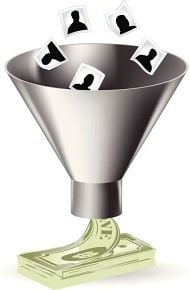#3 – CONVERSION
 Conversion is the third essential inbound marketing element. Prior to focusing on conversion you should set goals (the first of 5 essential inbound marketing elements) and implement traffic generation (the second of 5 essential inbound marketing elements) tactics in order to effectively convert visitors into leads or customers.
Conversion is the third essential inbound marketing element. Prior to focusing on conversion you should set goals (the first of 5 essential inbound marketing elements) and implement traffic generation (the second of 5 essential inbound marketing elements) tactics in order to effectively convert visitors into leads or customers.
Converting users from point A to point B or from point B to point C requires a few items; Content, conversion paths and knowledge of the buying process (sales funnel). Developing and tying all of these elements together is crucial for successful conversions.
DEVELOPING CONTENT
The content in the conversion phase of inbound marketing is different than the content in traffic generation. The main difference is the commitment of the audience and their stage in the buying cycle. Blogs attract traffic scattered across all stages of the buying cycle, whereas content in the conversion phase addresses certain mindsets users are in, based on their stage in the sales funnel.
Content aiming to convert users is educational and detailed, thoroughly addressing a specific topic, question or issue. Examples of these types of content include eBooks, whitepapers, case studies, webinars and demonstrations. Content should be written for each stage of the buying cycle.
CREATING CONVERSION PATHS
Inbound marketing efforts should result in gaining consumers’ information and eventually their business. The conversion path plays an essential role in this aspect of inbound marketing by moving customers through the sales funnel; beginning with a call-to-action.
A call to action (CTA) should introduce visitors to the content you are offering and entice them to click on the CTA to learn more. CTAs should be placed throughout your website, at minimum one per page.
The CTA will bring you to the entry point for accessing the content, a landing page. This landing page will clearly indicate what the content is, its benefits and reasons for downloading. Also, it must have a form that requires users to provide certain information. This is your opportunity to learn about who is interested in your products or services, or at the very least, has an issue your products or services can address. The key here is to provide content valuable enough to motivate users to give you valuable information.
Upon submission users are brought to a thank you page. Simultaneously, an email can be sent to users (if you requested that detail on your landing page). Both elements serve the same purpose. They are follow-up tools that will provide the content as a link, thank users for downloading the content and provide additional CTAs to keep users moving through the sales funnel.
STAGES OF THE BUYING CYCLE
There are three stages in a buying cycle regardless of the product or service being purchased.
- Perform Research – at this stage visitors are trying to gain an understanding of the market and what options are available. Visitors are looking for an answer to a problem.
- Establish Buying Criteria – research is done. Visitors know they have a problem and how to solve this problem. Visitors are trying to determine requirements for the solution that needs to be purchased.
- Evaluate Vendors – visitors are ready to buy and are trying to decide who to buy from.
Your website visitors’ readiness to buy will range from no interest to buy to immediately ready to buy, and everything in between. For this reason you need content that addresses each phase of the buying cycle.
INTEGRATING ALL CONVERSION COMPONENTS
Content for the “Perform Research” phase should be very educational. In the “Establishing Buying Criteria” phase a user is looking for detail-heavy product specific content. Finally, the “Evaluate Vendors” phase should feature personal, hands-on content or interaction. Here are some content examples for each phase of the buying cycle.
- Perform Research
- eBooks
- Whitepapers
- Checklists
- Establish Buying Criteria
- Webinars
- Content Kits
- Case Studies
- Evaluate Vendors
- Demos
- Consultations/Assessments
- Trials
Each phase of the buying cycle will request and require different information from users. The visitors’ readiness to buy will determine the willingness to provide personal information. For example, visitors in the “Perform Research” stage do not want to be contacted by a salesperson, so don’t ask for a phone number at this point. Visitors ready to buy will likely hand over a phone number because they want to be contacted by a salesperson.
Our final two blogs of the series will cover lead nurturing and analytics. Like us on Facebook, follow us on Twitter or stay tuned to our blog updates to read details covering the next essential element of inbound marketing.
